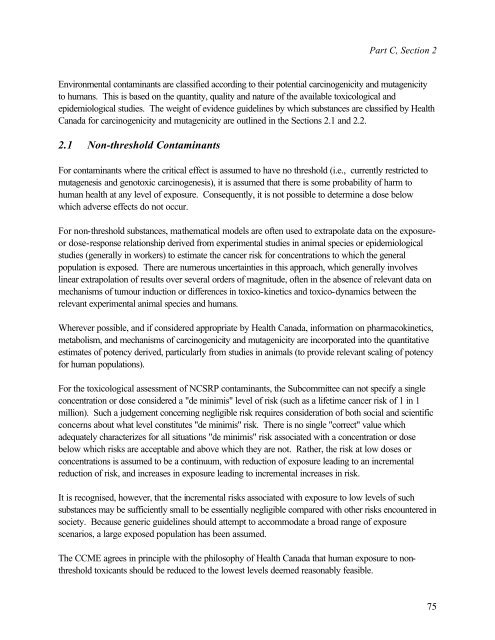Protocol for the Derivation of Environmental and Human ... - CCME
Protocol for the Derivation of Environmental and Human ... - CCME
Protocol for the Derivation of Environmental and Human ... - CCME
Create successful ePaper yourself
Turn your PDF publications into a flip-book with our unique Google optimized e-Paper software.
Part C, Section 2<br />
<strong>Environmental</strong> contaminants are classified according to <strong>the</strong>ir potential carcinogenicity <strong>and</strong> mutagenicity<br />
to humans. This is based on <strong>the</strong> quantity, quality <strong>and</strong> nature <strong>of</strong> <strong>the</strong> available toxicological <strong>and</strong><br />
epidemiological studies. The weight <strong>of</strong> evidence guidelines by which substances are classified by Health<br />
Canada <strong>for</strong> carcinogenicity <strong>and</strong> mutagenicity are outlined in <strong>the</strong> Sections 2.1 <strong>and</strong> 2.2.<br />
2.1 Non-threshold Contaminants<br />
For contaminants where <strong>the</strong> critical effect is assumed to have no threshold (i.e., currently restricted to<br />
mutagenesis <strong>and</strong> genotoxic carcinogenesis), it is assumed that <strong>the</strong>re is some probability <strong>of</strong> harm to<br />
human health at any level <strong>of</strong> exposure. Consequently, it is not possible to determine a dose below<br />
which adverse effects do not occur.<br />
For non-threshold substances, ma<strong>the</strong>matical models are <strong>of</strong>ten used to extrapolate data on <strong>the</strong> exposureor<br />
dose-response relationship derived from experimental studies in animal species or epidemiological<br />
studies (generally in workers) to estimate <strong>the</strong> cancer risk <strong>for</strong> concentrations to which <strong>the</strong> general<br />
population is exposed. There are numerous uncertainties in this approach, which generally involves<br />
linear extrapolation <strong>of</strong> results over several orders <strong>of</strong> magnitude, <strong>of</strong>ten in <strong>the</strong> absence <strong>of</strong> relevant data on<br />
mechanisms <strong>of</strong> tumour induction or differences in toxico-kinetics <strong>and</strong> toxico-dynamics between <strong>the</strong><br />
relevant experimental animal species <strong>and</strong> humans.<br />
Wherever possible, <strong>and</strong> if considered appropriate by Health Canada, in<strong>for</strong>mation on pharmacokinetics,<br />
metabolism, <strong>and</strong> mechanisms <strong>of</strong> carcinogenicity <strong>and</strong> mutagenicity are incorporated into <strong>the</strong> quantitative<br />
estimates <strong>of</strong> potency derived, particularly from studies in animals (to provide relevant scaling <strong>of</strong> potency<br />
<strong>for</strong> human populations).<br />
For <strong>the</strong> toxicological assessment <strong>of</strong> NCSRP contaminants, <strong>the</strong> Subcommittee can not specify a single<br />
concentration or dose considered a "de minimis" level <strong>of</strong> risk (such as a lifetime cancer risk <strong>of</strong> 1 in 1<br />
million). Such a judgement concerning negligible risk requires consideration <strong>of</strong> both social <strong>and</strong> scientific<br />
concerns about what level constitutes "de minimis" risk. There is no single "correct" value which<br />
adequately characterizes <strong>for</strong> all situations "de minimis" risk associated with a concentration or dose<br />
below which risks are acceptable <strong>and</strong> above which <strong>the</strong>y are not. Ra<strong>the</strong>r, <strong>the</strong> risk at low doses or<br />
concentrations is assumed to be a continuum, with reduction <strong>of</strong> exposure leading to an incremental<br />
reduction <strong>of</strong> risk, <strong>and</strong> increases in exposure leading to incremental increases in risk.<br />
It is recognised, however, that <strong>the</strong> incremental risks associated with exposure to low levels <strong>of</strong> such<br />
substances may be sufficiently small to be essentially negligible compared with o<strong>the</strong>r risks encountered in<br />
society. Because generic guidelines should attempt to accommodate a broad range <strong>of</strong> exposure<br />
scenarios, a large exposed population has been assumed.<br />
The <strong>CCME</strong> agrees in principle with <strong>the</strong> philosophy <strong>of</strong> Health Canada that human exposure to nonthreshold<br />
toxicants should be reduced to <strong>the</strong> lowest levels deemed reasonably feasible.<br />
75
















